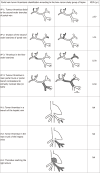Treatment of hepatocellular carcinoma in patients with portal vein tumor thrombosis: Beyond the known frontiers
- PMID: 31496618
- PMCID: PMC6710186
- DOI: 10.3748/wjg.v25.i31.4360
Treatment of hepatocellular carcinoma in patients with portal vein tumor thrombosis: Beyond the known frontiers
Abstract
Hepatocellular carcinoma is one of the most frequent malignant tumors worldwide: Portal vein tumor thrombosis (PVTT) occurs in about 35%-50% of patients and represents a strong negative prognostic factor, due to the increased risk of tumor spread into the bloodstream, leading to a high recurrence risk. For this reason, it is a contraindication to liver transplantation and in several prognostic scores sorafenib represents its standard of care, due to its antiangiogenetic action, although it can grant only a poor prolongation of life expectancy. Recent scientific evidences lead to consider PVTT as a complex anatomical and clinical condition, including a wide range of patients with different prognosis and new treatment possibilities according to the degree of portal system involvement, tumor biological aggressiveness, complications caused by portal hypertension, patient's clinical features and tolerance to antineoplastic treatments. The median survival has been reported to range between 2.7 and 4 mo in absence of therapy, but it can vary from 5 mo to 5 years, thus depicting an extremely variable scenario. For this reason, it is extremely important to focus on the most adequate strategy to be applied to each group of PVTT patients.
Keywords: Combined therapies; Liver transplantation; Percutaneous ablation therapies; Portal vein tumor thrombosis; Sorafenib; Surgery; Systemic chemotherapy; Transarterial chemoembolization; Transarterial radioembolization.
Conflict of interest statement
Conflict-of-interest statement: No potential conflicts of interest. No financial support.
Figures
References
-
- Ferlay J, Soerjomataram I, Dikshit R, Eser S, Mathers C, Rebelo M, Parkin DM, Forman D, Bray F. Cancer incidence and mortality worldwide: sources, methods and major patterns in GLOBOCAN 2012. Int J Cancer. 2015;136:E359–E386. - PubMed
-
- Bosetti C, Levi F, Boffetta P, Lucchini F, Negri E, La Vecchia C. Trends in mortality from hepatocellular carcinoma in Europe, 1980-2004. Hepatology. 2008;48:137–145. - PubMed
-
- Colombo M, de Franchis R, Del Ninno E, Sangiovanni A, De Fazio C, Tommasini M, Donato MF, Piva A, Di Carlo V, Dioguardi N. Hepatocellular carcinoma in Italian patients with cirrhosis. N Engl J Med. 1991;325:675–680. - PubMed
-
- Manzano-Robleda Mdel C, Barranco-Fragoso B, Uribe M, Méndez-Sánchez N. Portal vein thrombosis: what is new? Ann Hepatol. 2015;14:20–27. - PubMed
Publication types
MeSH terms
Substances
LinkOut - more resources
Full Text Sources
Medical


